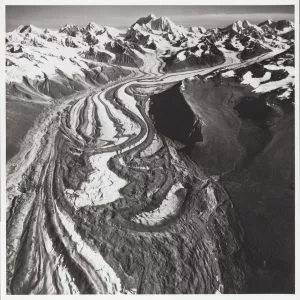NOAA@NSIDC and the University of Colorado (CU) Boulder Libraries are pleased to announce that the Glacier Photograph Collection (GPC) has recently been updated with over 8,000 new historical images, collected from 1883 through 2012. The GPC holds digital images of glaciers from around the world, most of which were digitized by scanning prints or glass negatives, but many that also originated in digital form. Some of the images date back to the mid-19th century and provide an historical reference for glacier extent. This update increases the size of the online, digital collection by 35%, bringing the total to approximately 25,000 glacier images. The new GPC images were created by scanning selections from a large analog collection of photographic prints that had not been scanned in earlier work. The analog collection, previously held by NSIDC, now resides in CU Boulder Libraries’ archive. Research was conducted to find and assign standard metadata, such as glacier name, photographer name, and glacier location, to each digital image; this was in large part carried out by CU archivists and interns. A grant from the Council on Library and Information Resources (CLIR) funded the work. In addition, images were cross referenced to the Global Land Ice Measurements from Space (GLIMS) glacier database. Now, someone looking at a photograph in the GPC would see a GLIMS ID in the photograph metadata that would allow them to find quantitative data about the glacier from the GLIMS database. The photos were acquired for a variety of reasons and by a variety of photographers, both amateur and professional. Several notable photographers in the collection are pioneer glaciologist, William Osgood Field; renowned photographer and glaciologist, Austin Post; and American geophysicist, Harry Fielding Reid. The GPC now houses the largest published collection of photographs from Field at 2,456 and from Post at 7,099. While the collection as a whole is not the result of a systematic monitoring program, many in the field shared their resources and built upon each other’s work. Often times, a later generation of scientists were returning to earlier glaciologist’s photo stations to make observations. For example, William Osgood Field revisited photo stations mapped by Harry Fielding Reid and the International Boundary Commission of 1893-1907. All of Field’s expeditions were based on repeat photography. He documented the same areas for six decades beginning in the 1920s, showcasing the fluctuations in glacier behavior and surrounding landscape. Beginning in the late 1970s, USGS glaciologist Bruce Molnia returned to these same stations to continue documenting glacier change and to build on previous work. To access these data, visit the Glacier Photograph Collection Search interface. Data Set DOI: https://doi.org/10.7265/N5/NSIDC-GPC-2009-12
Data Announcement
Over 8,000 Historical Photographs Added to the Glacier Photograph Collection Database
MONDAY, JUNE 10, 2019
